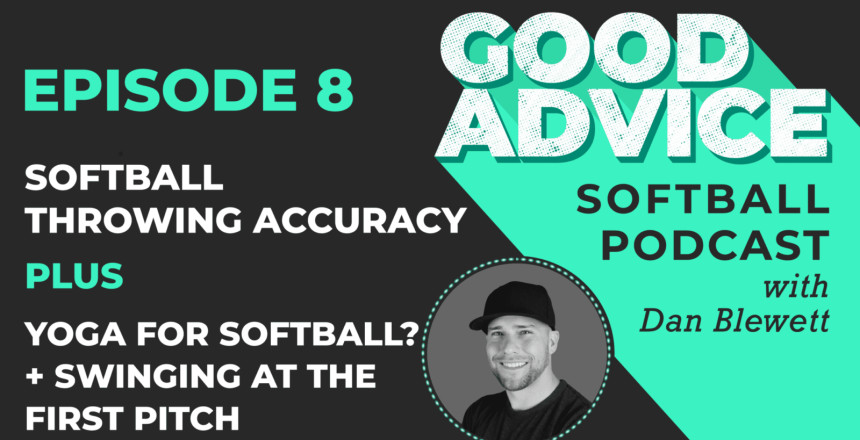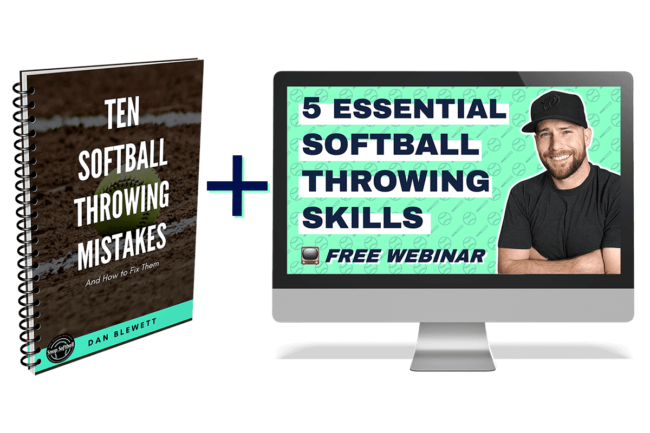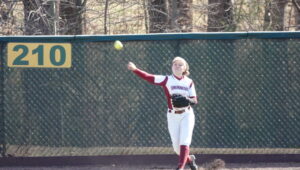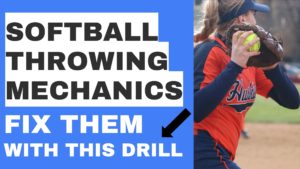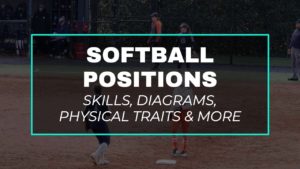*This article may contain product links which pay me a small commission if you make a purchase. Learn more.
Dan discusses softball throwing accuracy, whether yoga is good for softball players, and the mindset of swinging at the first pitch of an at-bat in fastpitch.
To submit a question for the Good Questions Q&A segment, make a voice recording and email it to Dan at hello@danblewett.com. Want to support the show? Enroll in one of Coach Dan’s online throwing courses or his mental skills course. Use code GOODADVICE to save 20% on any course, just for being a listener. Sign up for Dan’s Email list and get his free throwing eBook, and follow up with him on the interwebs: YouTube Channel | Twitter | Snapsoftball.com
Podcast: Play in new window | Download
Subscribe: Apple Podcasts | Spotify
Full Transcript: EP Good Advice Softball Podcast EP8 – Softball Throwing Accuracy Tips; Is Yoga Good for Softball and Should You Swing at the First Pitch?
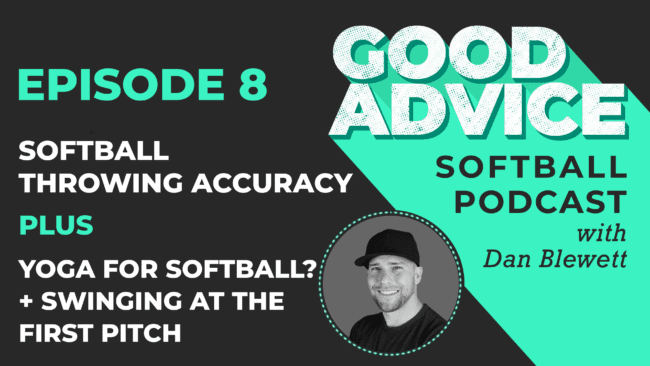
You are listening to the Good Advice softball podcast. I’m Dan Blewett. And on this show, you’ll learn how to help the softball player in your life. Sharpen her skills, improve her mindset and find new confidence through softball.
Welcome back to the good advice softball podcast. I’m Dan Blewett. And in today’s episode, we’re going to talk about number one is yoga. Good for softball players. Two, should you swing at the first pitch of an, a bat and three? Our question of the day is this is a little while back, you know, my daughter’s throat going with very poor softball throwing accuracy over to first base.
What are some of the fixes to increase throwing accuracy across the diamond? So, first off, um, here is yoga. So yoga is a really popular form of exercise. It’s a, it gets more and more claim. I think each year, not so much even for its physical benefits, but it for its mental health benefits. Um, and I think it needs to be clarified a little bit for not only female athletes, but also male athletes.
So. Yoga needs to be put in its own sort of bucket as to what it helps and what it doesn’t. So one of the, you know, as a strength coach and someone who owned his own Academy for a long time and did strength training with softball players, baseball players, all sorts of athletes, most young girls don’t necessarily need the training benefits that come from yoga.
Now. The, what that means is most young girls need a foundation of good strength training, where they’re going to stabilize their joints. They’re going to get stronger. They’re going to get more explosive. They’re going to protect their knees because most girls tend to lack again, overall, just overall body strength, but specifically strength in their lateral hips that helps protect their knees from injuries.
Cause ACL injuries are. 10 times the rate of, uh, that of male athletes. Um, so tend to have looser shoulders because they have a little bit less testosterone and the muscles in the rotator cuff aren’t quite as strong as they should be. To stabilize that joint and withstand the rigors of throwing. So for me, my goal was always to help young girls develop a good foundation where they get bigger and stronger and can really start to reinforce their joints in a sense, and avoid a lot of the common female athlete injuries, which again, our knees and shoulders.
So that being said, yoga is good for you or body awareness. It’s good. For course stability, which core stability is a little bit of a buzz word. Um, you know, you develop core stability from doing a front squat. You develop core stability from doing a plank. You develop core stability from doing farmer’s carries, which is holding heavy dumbbells and just walking.
So there’s a lot of ways to develop core stability. Yoga is just one of them. Um, But what yoga doesn’t really do is it doesn’t help you be more explosive. It’s not really sports specific. So there’s no like a rotational aspect, which is obviously very rotational sport. It doesn’t target any specific muscle groups necessarily.
It’s very whole body, which is fine. Um, but I think given. A limited training times. So say you only had two hours a week to get a softball player as strong and as physical as possible. Would you want to spend one of those hours doing yoga or both hours doing yoga? I think the answer is certainly no, because again, you can’t really be targeted in a way that meets the needs of female athletes and softball players in particular.
So. As far as the training modality, I think yoga tends to fit adults who are looking for healthy lifestyle choices and, you know, things to keep active, to free their mind after work, stuff like that. I think they’re more beneficial for males fleets because male athletes tend to have naturally more of the joint stability and strength compared to female athletes.
But men don’t have the natural flexibility that women have. And so women are probably better off the bat of yoga, but men seem to benefit more because it can really loosen up their hips and give them some of the flexibility and mobility that can hold them back. Whereas I haven’t met that many female athletes that are held back by flexibility, mobility issues.
So really in a sense, yoga tends to give female athletes a little more of what they’re already good at. Which is some of the flexibility, mobility based movements in a slow sort of controlled pattern. Now this isn’t blanket advice. This isn’t to say that you should never do yoga because there are definitely some benefits to yoga.
Um, number one, We know that, uh, females are a little more prone to depression nowadays, as a result of internet bullying, stuff like that. And this is a really big problem with social media. Um, I think it’s something that more and more people are becoming aware of. So one of the big benefits of yoga is.
That it helps us be present. You know, you put your phone away, you’re in the class, you’re focusing on your breathing. You’re focusing on the movements. Um, it’s a great meditative, healthy, um, mindset kind of activity. And so I think there’s a lot of benefits there that are just, that sort of transcend the physical stuff.
So. I think yoga can be a really great escape. And I know that’s how so many people use it. It’s a great mental escape from the daily grind from screen time, from all the harshness of this always on social media, internet kind of world. So I think given that side of the equation, I think there’s tremendous benefit for not only female athletes, but male athletes in general, in any, any person.
So given that. Everyone’s life is finite as far as their training time. Like that was a weird way of putting it, but everyone’s schedule has finite time in it, right. Training time. So if you’re going to say, Hey, I’ve got three hours a week to do softball, strength and conditioning. What does that look like?
Is it strength training? Is it sprinting? Is it, you know, long distance running? Is it yoga? Is it Pilates? You know, what, what should I be focusing on? I think for most female athletes who their main thing is they need to get more physical and that’s their, their biggest bucket that needs to be filled. Then I think yoga is probably not on their top three list of choices now for.
Athletes who are maybe a little more established. You have a training age of a couple of years. They’ve been doing hard strength conditioning for a couple of years, and maybe they are, um, in need of just some of the mindset I’m trying to be present, trying to, you know, decompress, get away from some of the stress over the recruiting trail, from softball, from school, from bullying, any of that stuff.
Then I think a yoga can really rock it up. The list of things that are priority. So I think it’s good as especially as young as you’d be and figure out what works for you. But at the same time, I don’t know that there’s many, uh, you know, middle school and high school athletes who are, who are gonna say, yeah, like I really built myself into this formidable player because of yoga.
I think yoga becomes an icing on the cake and an additional. Sort of specific, fine tuned kind of thing, especially as you start to older and get older, especially with boys who really have those joint flexibility, mobility issues. Um, but for everyone, as far as mindset stuff, because we both know that.
Meditation and visualization and some of this mindfulness practice, that’s so important for athletes. It’s critically important. It’s a tough pill to swallow, to just ask kids, just sit down and just, you know, close their eyes and focus on their breathing. But when you say, Hey, let’s go to yoga. That’s a lot easier.
It’s a, so it’s a fun thing to do. It’s a, it’s a thing that I think people will respect. Um, I think it’s something that gives people pride. They say, yeah, I go to yoga. It’s there’s like a PRI that it’s a, it’s a good, healthy thing to do. So if that’s something where yoga is a part of your team, because you know, it, it gives you that thing you’re excited to do.
That’s giving you that mindset training that you had mental training that you need in an easier to digest kind of form that I think that’s great. So hopefully we’ve talked through some of the pros and cons with yoga. Again, I don’t think it’s the most critical from a physical development standpoint for young athletes, boys, or girls, to be quite honest.
Um, because again, female athletes have a lot of the flexibility and mobility more naturally than boys do at that age. Um, and so, and what they really need is more of the harder. Tougher strength and conditioning, getting stronger and lifting real weights, especially in middle school, high school. So, but I do think it has a great place in wellbeing and mindfulness in a healthy mindset and just helping kids get away from what can be honestly, a really relentless kind of brutal, um, world and social media.
It’s, it’s tough. And I think it’s a great way to get off of the grid for a little bit and get back to basics.
Nine 92nd mindset today. Let’s talk about, should you swing at the first pitch and soft ball? So this is a really important plate discipline item that I think is, is too, too infrequently talked about. So. Sometimes coaches and players can get excited about swinging at the first pitch because they see a picture of there’s a lot of strikes.
Maybe they just cough it up, down the middle quite a bit. And then, Hey, let’s jump on this reality. The mindset of high level players is always I’m sure. Trying to find my pitch and I’m trying to drive it. So when that’s your main goal, and this is the main goal for really high level players, you know, the D one, the, the, the pro athletes, this is their mindset, which is, I know what my pitch is, and that takes a long time to figure out as well.
Um, and when I get it, I’m not going to miss it. And so when that’s your mindset, I’m looking for my pitch and when I get it, I’m gonna smash it, it doesn’t really matter what the count is. It could be one, two, it could be three, one. It could be three. Oh, it could be. Oh. Oh. And so when we start to get into this mindset of.
Hey, let’s jump on the first pitch. Sometimes that can be misinterpreted and misconstrued as I should swing at the pitch on the front, or I should swing at the first pitch more often than not because coach said so, or because we need to be aggressive. And now what happens is they start to expand the list of good pitches that are, that they’re going to try to drive.
So now, if you’re in this mindset of I’m going to attack on the first pitch, pitcher throws an outer third fast ball, and now you swing at it because you’re trying to swing at the first pitch and be aggressive. Now you just ground up there short and that about was wasted. So really no matter what the count should be, the mindset should always be.
It doesn’t matter what the count is. I’m going to swing at pitches that I can drive. And I’m going to take pitches that I can’t, unless I’m in a situation where I need to swing at something to get a runner over, or to get a runner in, you know, if it’s running on third and one out or whatever it might be, unless there’s some special circumstance, I just need to wait for my pitch.
And when I get it not miss it. And so that’s more of the thing. And so I would urge coaches and players not to get into this jump, the gun mindset, where they’re really overly eager to swing a certain pitch, right. Certain counts, just because a pitcher might be falling into a pattern because you have to judge every pitch on its individual merits.
And that means it doesn’t matter what count it is. Can I drive it? Is it my pitch? If the answer is yes. Then smash it. If the answer is no, then take it. All right. It’s time for good questions. Our listener Q and a segment. Remember if you have a question you’d like answered on the show, please email a voice recording to hello@danblewett.com.
This is easy to do on your phone, through the voice memos app on iPhones or any voice recorder app on Android links to email me are in the show notes. Lastly, our question of the day is. How can I reduce wildness? So throwing across the diamond, you know, my daughter has been, you know, missing high, missing, high up the line towards the plate.
She’s struggling to be accurate across the diamond. What can we do about that? So, number one, the biggest reason for overthrows in my experience are mental. These are when the player gets the ball. They realized they have a lot of time or they realize they have too little time. They realized the runners really hauling down the line, or they’re very present about not making a bad throw, which becomes a self fulfilling prophecy, or they’re really nervous to make it to not make a bad throw.
So. Meant the mental side of softball and baseball as sister brothers sports there, it’s terrible. It’s a very hard sport for me, the mental aspect. And that’s because there’s often this time gap where you’ll have the ball and say, Oh, I’ve got this. I should hopefully not blow this opportunity. Oh, the bases are loaded.
Everyone’s counting on me. Oh, this is a really big pitch. If she gets a hit, I lose the game. Oh, I just got this ground ball. I have plenty of time and I hope I don’t make a bad throw. That’s a really underrated, um, thing as far as. The credit, we give her players getting through that and how much it can really derail a performance.
We’ve seen this over and over when you don’t play player makes an error. And then what happens then they make more, probably more prone to make an error later in the game because they’re pressing, they’re trying too hard and they’re trying to not make another error. And again, this whole trying to hard thing is, is the enemy of, of.
Good play. It’s just so hard when you start to try harder and press to not go the opposite direction. So number one, look for mindset clues. Um, often those things, big ones where you’ll just see players tense up. You’ll see their arm action change. You’ll see them. You know, cut their throw short. They won’t throw it as fluidly.
They’ll stop there. Their fall through early, those are all signs that they’re really trying to guide the ball to first base, instead of just throw it the way they know how to do so. So that’s the one pro one of the biggest ones. Cause, cause here’s the thing I want you to remember. No matter what your mechanics are.
But if you make that throw with your terrible mechanics over and over and over, you’ll figure out what trajectory and speed to throw it. So it lands in the first baseman’s Mitt. That’s the thing that I want people to remember. Most it isn’t just there’s Oh, my daughter’s mechanics are off. So therefore she makes bad throws.
It’s more. The variability in the mechanics. So if she’s got good clean mechanics, one throw, then they’re different. The next throw or her arm slot is one angle this time than one angle, the next, which is actually a very common thing for infielders, right? I’ve talked about this on my YouTube channel a ton where you need to be able to throw on different arm angles.
They’re just like different tools to do the same job. Um, but when there’s more variability in the, in the throwing motion, that’s when you see problems start to happen. And so. Really it, it still comes back a lot of times to mindset when they’re afraid to make a bad throat, or they’re thinking about their throw.
They have too much or too little time, and they’re not just instinctive and just throw it naturally. That’s typically when we see most problems. Cause again, it doesn’t matter what her mechanics are today. It honestly doesn’t. They could be again, super weird. She could even kick the thing across the diamond because as long as she’s repeating it and she’s not overthinking it, she’s not guiding it.
She just throwing it. It’s going to get there more often than not, you know? And, and, and this is, I think, proven to be true when you watch high-level softball and baseball players, they can make throws across the diamond on the run to the left, to the right straight, you know, from sidearm, from over the top, from subside arm, across their body, with their chest open with their chest closed in fuelers throat.
Essentially, they never make the same throw twice in their whole career. You know, they’ll never essentially throw the same or a ball from the same location on the diamond at the same velocity, from the same arm slot. It’s extremely rare. It’s when you really, really think about it. Um, and so when you start to really put it in that perspective, through that lens, you start to say, okay, if infielders always have sort of different mechanics from throw to throw, uh, what is the, what is the variable behind.
Control and control problems. And really it comes back to mindset. If you go out there and take enough ground balls and have her make all these different throws and have her make throws from different spots on the field, make the tough throws and practice over and over and over it becomes what second nature.
And they’d get the ball and they throw it and they don’t think about it too much. You know, they get the ball and they have plenty of time. They just take a couple extra shuffles. Don’t think about it and throw it. It’s about staying present. And a lot of players, they can make the plays when they’re hit harder and they just have to get rid of it.
But then when they get the, I only have time that’s a lot of times in the air mail. It. So, you know, it just depends. Um, obviously one caveat to that is a lot of players sometimes will get the ball and think they have to get rid of it too fast. So they’ll get it. And they’ll immediately try to throw without collecting themselves and using good mechanics.
That’s also a problem. So you’ll know when you need to tell a player, Hey, you know that one hopper right too. You don’t feel like you just need an airmail at right away. Get it to your center, funnel it up, you know, take a couple of Crow hops and then throw it, but collect yourself and then make the throw.
So rushing can also be a problem, not just having too much mental time, but, you know, I wish there was a tried and true quick answer, but. There really isn’t. I mean, it, it, it doesn’t really come down to mechanics. It really comes down to mindset them, understanding how to be present and not overthink the throw, not worry about it, not get anxious.
Um, because that’s, when you, you started becoming robotic and you guide a throw, you ease off a throw, you know, you. You’d start thinking about stuff you don’t need to throw where if you go out there and take enough ground balls, and this is really the action item. So if you, if your daughter’s struggling or player on your team is struggling with, with command across the diamond, how many ground balls she taking a week?
Go out there and hit her bucket after bucket, after bucket, roll on whatever and give her the practice. She needs to be automatic, just like riding a bike when getting a ground ball and throwing it becomes automatic. You just sort of, you eliminate that time gap and you eliminate our stupid human brains from getting in the way of making the thing or making the plan that we know how to do.
Well, that’s all the good advice I’ve got for today. If you enjoy the show and would like to support me while also helping yourself enroll today. And one of my online softball courses, my she’s got a Canon throwing courses come with pricing plans for any budget. And my resolute athlete, mental skills course will help your daughter or team build the mindset of a champion.
Enroll in any of my courses through the links in the show notes and save 20% with code good advice just for being a listener. Be sure to subscribe to my weekly email list where you’ll get updates on all my new videos and episodes, nearly 4,000 people get my emails and you should to sign up for the link in the show notes.
Lastly, who do you know, who can use some good advice? Please share this podcast with a friend, subscribe on iTunes, Spotify, or wherever you listen to podcasts and subscribe to my snap softball, YouTube channel, where you’ll find this podcast and hundreds of softball, instructional videos. Back when I was a player, I was always thankful for good coaches and good advice.
I’m Dan Blewett and I’ll see you next time. .

